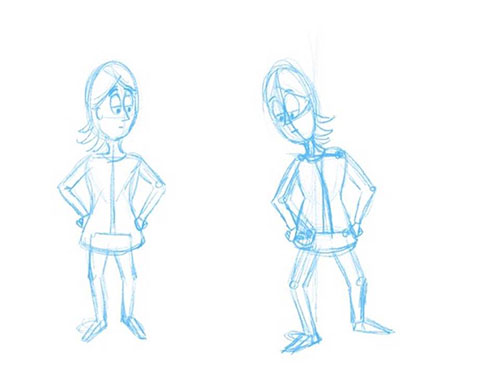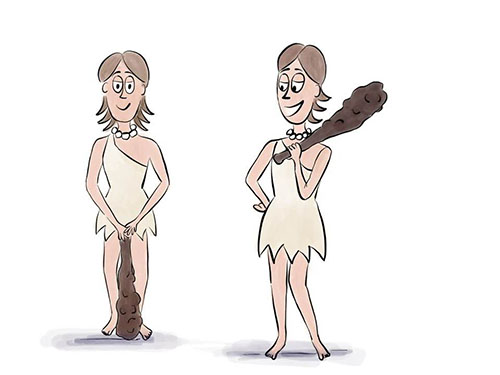Stick figure cartoon

Vicky’s head was feeling tight with frustration. Her jaw was set and her teeth clamped tightly together as she erased her character’s arms and re-drew them …for the fourth time!
“Grrr!” she thought. “Redrawing the whole arm over and over is such a pain! I wish I could get it right more easily.”
Do you also struggle to get the right pose, the right feel to your cartoon figures? Then you rub bits out and draw them over.
And over.
And over?
If so, perhaps this recent interaction about a stick figure between two pretty advanced cartoonists on my Beyond Da Vinci course will inspire you. They were working on an assignment to add dynamism to their poses, one small technique at a time, when one of them posted this:
“I still draw all my cartoons starting with a stick figure cartoon. They help me with the proportions.”


As you see, her finished work is impressive; she uses it regularly in her professional presentations and information products and also to illustrate greeting cards for clients and friends. But she still starts off each cartoon extremely simply and tweaks her stick figure cartoon until the proportions look good enough to add the rest of the bodies and clothes.
No sooner had she shared her process, someone else chimed in, “Thanks for sharing the sticks also. Good idea to work much more with stick figure cartoons again!”
Now these folks have been cartooning solidly for 18 months
They are super-industrious, working like nut-hunting squirrels every day throughout the course and during several self-study breaks.
Yet their interaction reminded me of three good reasons we can all keep using stickmen — or go back to using them, if you’ve stopped:
- Stickmen help enormously with proportions.
- They’re easy to troubleshoot and change and
- That saves you time.
Drawing Proportions can be challenging
Especially as you move into more complex poses with the twisting, titling and foreshortening that comes with different perspectives. Using stick figures to work that out makes good sense.
Using a stick figure cartoon it’s easier to troubleshoot
You can change stick figures easily because there are fewer lines to deal with, so there’s less background visual clutter. Apart from that, you don’t have as much time invested at that point, so you feel more inclined to tweak and fix before you go any further.
Admit it, saving time is a big plus
Making time to cartoon well is good for our professional work (cartoons help clients engage better with our ‘real’ work) and also for our mental health (creative pursuits have measurable physiological effects on stress markers like blood pressure and brain waves). Why would you choose to spend more time cartooning only to get to a similar (or worse) outcome?
All in all, this interaction was an eye opener. It’s a reminder me again that basic skills — like drawing a stick figure cartoon — are worth revisiting on a regular basis. That they often have as much purpose when you’re working at a higher level as they do when you are just starting out. And that sharing our process with fellow artists can be both a blessing and an inspiration.
Grab your pencil.
Today’s a good day to draw some stick figure cartoons!
My most sincere thanks to Pauline Le Rutte of Conduite for the use of her images, and Sylvia Wonisch of Buntleben for her words, and to both of them for their ongoing, personal encouragement.
***
Questions? Suggestions?
If you’re not 100% clear about these drawing stroke exercises (or you have a question about something totally unrelated to this video), I’d love to hear from you.
Leave a comment and who knows? Your question could spark off an exciting new lesson series!
***
Interested in drawing your own cartoon characters from scratch?
